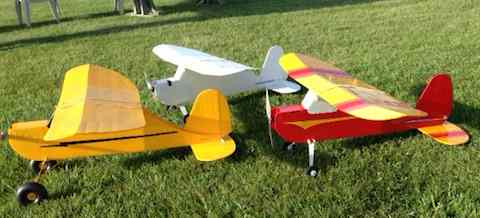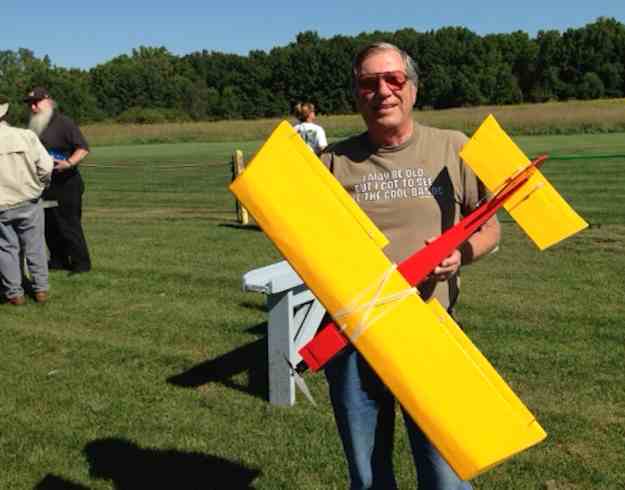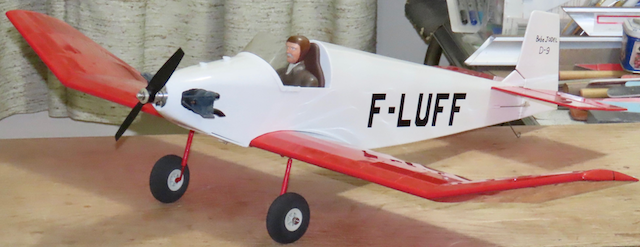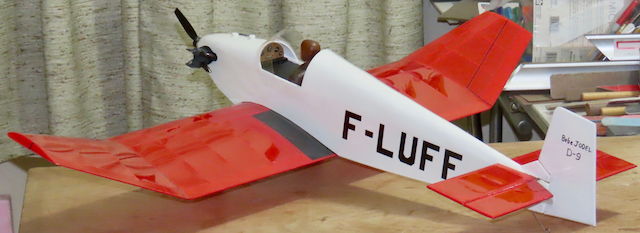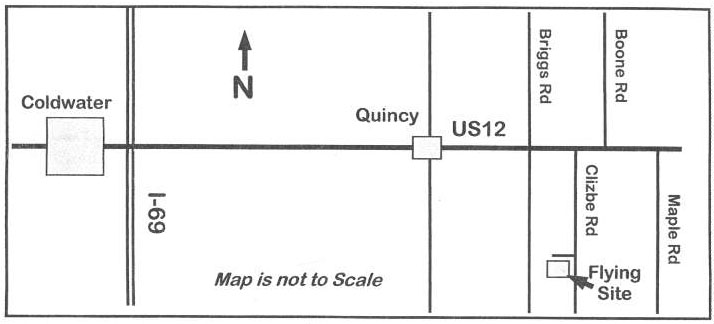 |
Flying High With Electric Power!
The Ampeer ON-LINE!
Fly the Future - Fly Electric! |
|---|
Site Table of Contents
| President: | Vice-President: | Secretary-Treasurer: |
| Ken Myers | Keith Shaw | Rick Sawicki |
| 1911 Bradshaw Ct. | 2756 Elmwood | 5089 Ledgewood Ct. W. |
| Commerce Twp., MI 48390 | Ann Arbor, MI 48104 | Commerce Twp., MI 48382 |
| (248) 669-8124 | (734) 973-6309 | (248) 685-7056 |
 | ||
| Board of Directors: | Board of Directors: | Ampeer Editor |
| David Stacer | Arthur Deane | Ken Myers |
| PO Box 75313 | 21690 Bedford Dr. | 1911 Bradshaw Ct. |
| Salem, MI 48175 | Northville, MI 48167 | Commerce Twp., MI 48390 |
| (313) 318-3288 | (248) 348-2058 | (248) 669-8124 |
| EFO Meeting, Wednesday, Feb. 10, 2021, 7:30 p.m.
Place: ZOOM, details to be sent via email | ||
| A Summary of MY Experiences Working With Foam Board Ken Myers summarizes his experiences with Dollar Tree Foam Board and FliteTest in a presentation to the Midwest RC Society. | Even More Info On Designing With Foam and Foam Board Type Airframes Arthur Deene shares even more information about foam board planes. | |
| Some of My Dollar Tree Foam Board Planes Keith Beattie tells us about some of his FT Dollar Tree Foam Board planes. | Keith Shaw's New Bebe Jodel Keith Shaw fills us in on his latest project. | |
| A The January 2021 Zoom EFO Meeting The happenings at the January 2021 EFO Zoom meeting. | The Upcoming Keith Shaw Birthday Party Electric Fly-in 2021 Upcoming Event Announcement | |
By Ken Myers On Wednesday, January 6, 2021, I presented information about what I've learned while working with foam board and summarized my experiences with a few FliteTest planes to the Midwest RC Society during their monthly Zoom meeting. What I presented follows. KM Designing and Building With Dollar Tree Foam Board
Background: I have built several Dollar Tree Foam Board airplanes over the past several years. Two were based on designs from FliteTest. The other two were of my own design. Useful FlightTest Links:
FliteTest on YouTube
Who and What is Flite Test?
Since the FT partnership with amain hobbies, the output of new airframes has markedly decreased, kits are not as readily available and the prices for FT power systems has risen much faster than inflation.
In early 2016 I built an enlarged version of the FliteTest (FT) Old Fogey. I enlarged 1.22 times to use a power system that I had on hand. There are areas in the FT build that require folds over or under parts, so the slots, where the folds are, need to be adjusted to the correct width. A 2D CAD program was used to enlarge the plans and adjust the slot cutout widths. Since it was my first DTFB build and FT designed plane, it became my learning experience regarding the material strengths and weaknesses, as well as the design ability of Josh Bixler.
There is a lot of information to be learned from those articles. After flying it for quite awhile, I gave the final version of my Old Fogey to Tim Young.
After finally working out the bugs in the Old Fogey, I wanted to see if I could build a simple Ugly Stik/Ugly Stick type plane, but I wanted to see if I could build an airfoil based on a "real" airfoil. The NACA 2412 was my chosen airfoil, and it worked out reasonably well. It did require a bit more effort, but I think it was worth it.
I still have, and fly, this Ugly Stik. My Award Winning Flite Test Simple Cub
In part 5 I noted that a part 6 would follow, but I never completed and published part 6. The following are the links to the draft of my final version, version 5.
Again, there is a lot of useful information in those articles. 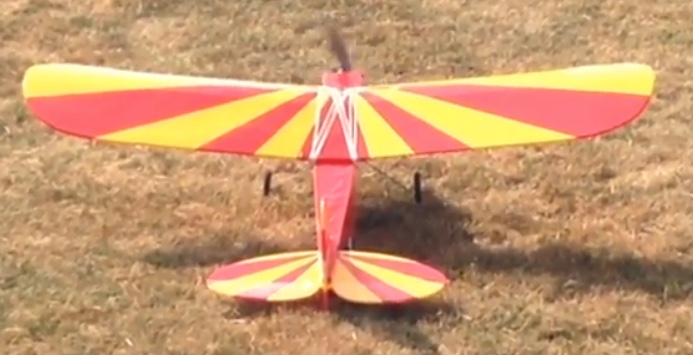
Version 4 I still have and fly the version 4 Simple Cub, which is covered with Econkote. 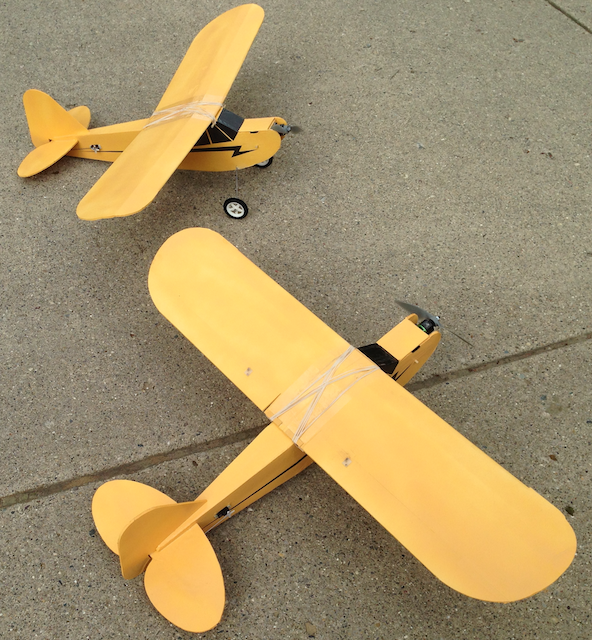
Both Version 5s I have the 3-channel version 5, which I use for training after introduction training using the RUA (Really Ugly Airplane) 2-4-10. I still love flying the 4-channel version 5 Simple Cub for sport flying. Both of the version 5 Simple Cubs are painted with stick-on graphics applied to the yellow paint. It is no secret that for many decades I've been trying to find the "best" trainer for my student pilots and training technique. The one that I finally found that was best for my teaching style and methods was the FMS SuperEZ.
Since I was well into the use of DTFB construction, I thought that I could design a decent flying, inexpensive and somewhat disposable airframe for training using DTFB. I was pretty sure that I wanted something along the lines of the Leisure Amptique. An Amptique and My RUA 2-4-10 Before getting into the design, I refreshed my memory regarding basic design proportions by rereading "Basic Proportions for R/C Model Aircraft"
I also reviewed Keith Shaw's "Building and Flying Electric Sport Scale" a Transcript of Keith Shaw's presentation to the 1992 Electric Model Fliers of Southern Ontario General Membership Meeting, March 1992. It was transcribed by Martin Irvine of Kingston, Ont. While the article by Keith relates to constructing a typical balsa and plywood construction plane, there is also a lot of information regarding general design decisions. 
Two RUA 2-4-10s I knew that I wanted to use the same construction as the Simple Cub wing, but I wanted to built as large as possible, span wise, using two widths of DTFB. I also realized the errors that were designed into the original FT design Simple Cub, and set out to avoid them For one thing, I built 2 degrees of wing incidence into the fuselage design. I did not want the landing gear to be attached to the interior of the foam board fuselage. I'd recently seen a landing gear design, similar to the one that I used for my design, in a magazine. I decided to "borrow" the design. Using the design articles, the Amptique, and other tips and tricks I'd learned over the years, as well as what I'd learned from working with DTFB, I created a prototype. To keep the design simple, only a 3-channel version was designed. I fly it with the rudder channel mixed 100% to the aileron channel so that my students can use the "rudder" stick on the ground and the "aileron" stick in the air. The rudder and elevator servos are placed way back in the fuselage, near the tail. To achieve the proper CG, without adding weight, the nose of the prototype was shortened and lengthened several times until it was "just right". That's very easy to do with foam board and glue. I suggest that two airframes be built at once, as the two airframes only require 10 sheets of DTFB and the second plane provides for a back up. Everyone knows that if you have two of something, the first one will last much longer than if you only have one of it.
The RUA 2-4-10
My preferred adhesives are, Aleene's Original Tacky Glue and 15-minute epoxy. For tape I use packaging tape and strapping tape. Other tools and supplies that I use can be found here. I use a fairly thick, inexpensive Yoga mat to cut on. It is much cheaper than a cutting mat and can be discarded if it gets too cut up, but mine is still just fine after lots and lots of builds, including 9 complete RUA 2-4-10s. Yeah, each prototype had some changes to it. Greg Eilers, Midwest RC Society president, suggested that we might want to have a "One Design" plane contest where everyone flies the same plane through a series of events. That could be a lot of fun. Pete Waters put on a few simple events for us a couple of years ago, and they were a lot of fun. Thanks again Pete! Greg suggested that we might want to consider the FT Stick design as he'd seen Paul Sockow's fly, and it looked like it performed well. Unfortunately, the Flite Test Simple Stick "Maker Foam" Electric Airplane Kit (1067 mm) has been on backorder for more than three months now. The construction video was released on YouTube on August 11, 2020. Although their typical practice has been to release the plans to the public, FT has not yet made the plans available. The FT Simple Stick is based on a design by a person known only as The Hangar or sometimes The Hanger.
If you think you might want to give foam board a try, you might want to download a set of PDF plans from FliteTest just to try the building techniques. With just a few dollars worth of foam board, you could learn a lot about their techniques, and you wouldn't even have to make it flyable. The choice would be yours. You can find a plane in the FT Store that you might like to try. Note the name of the plane and then go to www.flitetest.com. Type the name of the plane in the search box. I chose Tiny Trainer and it came up with a link to Flite Test | Tiny Trainer BUILD. The FT Tiny Trainer Build page has a link to the build video at the top of the page and the links to the free plans near the bottom of the page. I did not provide the URLs for the Tiny Trainer, as I wanted you to find it on your own so that you could find others if you so desire. Have fun and keep building models! Addendum: During the presentation, Larry Markey asked what brand of motors I recommend and what "size" I was using. I incorrectly stated a Cobra 2017-20 with about a Kv of about 960, from memory. My response was incorrect because the "best" answer would have been a 72 gram 960 Kv motor. Weight and Kv are the "best" way to compare motors, as the numbers like 2217 vary on how the manufacture or supplier want to name their motor. Some use the exterior bell size while others use the stator size.
That page contains a great deal of useful information about that motor. I also should have mentioned that I like the motors from Innov8tive Designs because Lucien Miller provides actual test data for the motors that he sells. Larry recommended that I look at the Sunny Sky brand. I noted that I was familiar with that brand but didn't know where they were sold anymore. He said they are available in Ohio. I found them available at SunnySky USA. I found the Website difficult to navigate, as there were a lot of different names for the motors they sell; Angel motors, EOLO Motor, F3P Motors, M motors, Other Multirotor Motors, R motors, V motors, X motors, X V3 motors, and XS motors. I looked at each of the motor "lines" and found that the majority did not provide the motor weight, nor maximum amp draw or suggested voltage range. While poking around in the motors, I did find their prices were reasonable, for sure, but for ME, I could not find enough information to order one. Even More Info On Designing With Foam and Foam Board Type Airframes
Ken, I see you are the speaker at the next MRCS meeting and that the subject is foam construction. I would like to suggest that you include a link in your presentation to videos on YouTube from both "Experimental Airlines" and "Andrew Newton". If you subscribe to these videos (free) you can quickly get a listing of all their uploads. The information on the Experimental Airlines site is particularly interesting. His video on covering foam board with tape provides many tips to make the job quick and reliable. He also provides information on tests he has made to compare various wing spar constructions. Overall a site with a lot of useful foam board construction info. I was also interested in the lightweight covering tape he recommends from Tapebrothers.com. It is a thin 2 mm clear tape with colored adhesive. The Andrew Newton's videos are more about building and flying foam planes. He flies several foam sailplanes which should be of interest to our sailplane group. He also has several equipment tests documented. One I was particularly interested in details a radio system that had a return to base feature and will not allow the motor to start until the plane had been hand╩ launched Hope this helps. Stay safe and let's hope 2021 will be a better year. AJ Some of My Dollar Tree Foam Board Planes
Hi Ken, I'm really looking forward to you presentation (at the Midwest Zoom meeting KM), especially the design part for the foam board planes. As a new person to the hobby I really enjoy scratch-building the Flite Test models. I was successful flying the FT Arrow (Wing) regularly. I crashed it twice. The second time was not repairable. 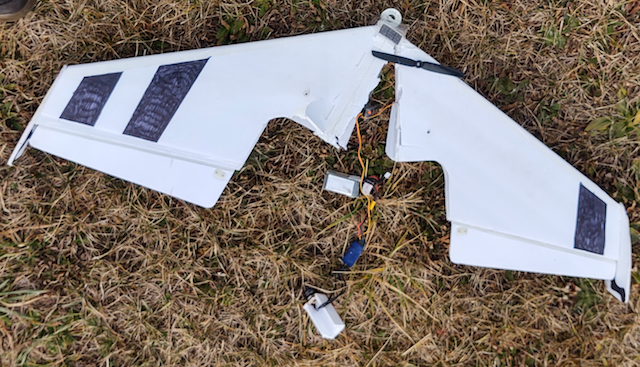 No worries. It was only $3 for more foam and electronics survived. 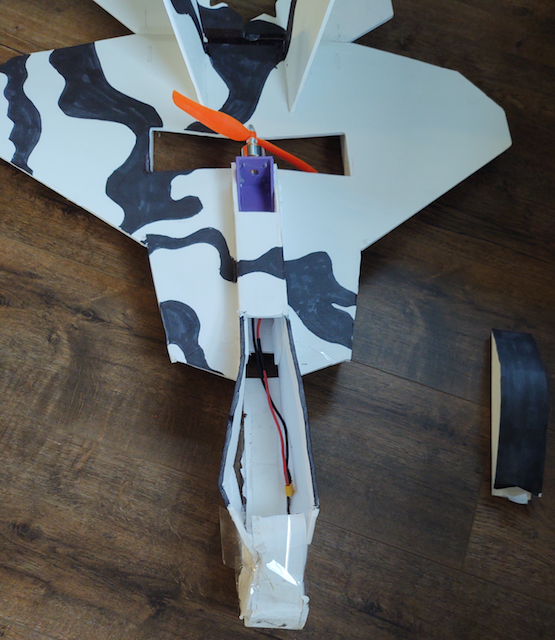 Then I built the FT F22 Raptor. I had many successful hand launches, flying and landing it. I crashed and rebuilt the F22 twice. The motor mount is 3D printed. It uses a 1400 Kv motor and a 3S battery. 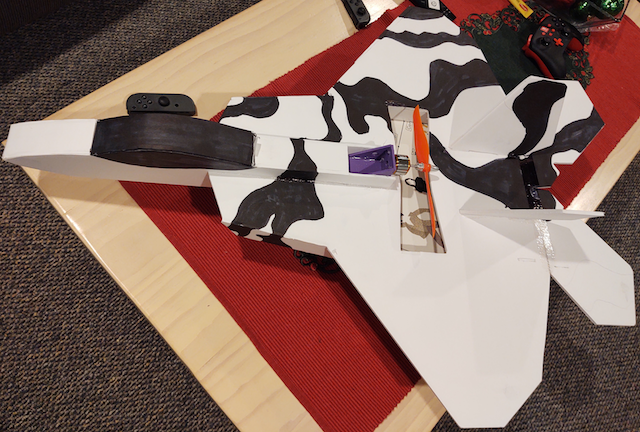 The paint scheme was done with a Sharpie. The control horns are╩repurposed╩dental flossers.  The plane still flew with the nose field taped together. My next plane is going to be a FT Baby Blender. I just purchased the Mitsubishi Zero precut model from Flite Test. I've been watching the build video for Zero. I really╩like╩the way it was assembled. See you soon,
Keith Shaw's New Bebe Jodel
I finished this Bebe Jodel a few days ago and even got a short test flight on it yesterday. (He's since had a few more flights. KM) The Bebe was a cute French homebuilt from the late 40s with only a 23' span and powered by a 25hp Poinsard flat twin. A loooooong time ago I built a 40" model with a BabyBee 049 and a rudder-only escapement, loosely based on a Midwest kit of the era, and covered with red silk. With bulby Trexler tires, it was one of the first planes I had that could reliably take off from the ground. I have many fond memories of it just trundling around the sky in all its funky glory. Over the last few years I have been having a lot of fun flying ultra low powered planes on calm evenings, just letting them float around and make slow passes, sort of radio-interfered free flight. I remembered the Bebe and thought it would be a great addition to these evening outings. I opted for a slightly smaller model this time (34") so that the wing could be built from 36" wood. It is powered with an Astro 010 on a 2S LiPo pack, and initially weighed in at 10 oz. After the first flight I had to add an ounce to the nose as it was showing signs of mild divergent tail-heavy behavior. With 220 sq.in., it now has a wing loading of 7oz/sq.ft. and a Q of 5.8 About the only grump was that I designed the front end for a beautiful 30mm collet spinner I had. However when I went to install it, the collet broke while I was hand-tightening the prop nut. :-O Right now it has a standard grub screw drive hub. Somewhere I have another 30mm spinner (they are quite rare), so will need to start going through the hoard of boxes in the basement. Time to clean off the building board for the next project. Keith
The January 2021 Zoom EFO Meeting The Wednesday, January 13, 2021 EFO meeting was held at 7:30 p.m. on Zoom.
There were 11 members and guests at the meeting.
Keith Shaw shared the information on his Bebe Jodel. He also recommended to look up a YouTube channel called domoremath.
He noted that this fellow flies a lot of rubber powered free flight models in New York City.
I checked it out and found it quite interesting watching some of his videos. KM
Jim Young was able to attend our meeting, and he's slowly getting "back into it" now.
He shared his latest, a Taylorcraft, rubber power model free flight model converted to electric RC. He plans to fly it in the open space across the street from his house.
He is working on a Yellow Jacket electric rudder, elevator, spoiler glider with a V-tail. He noted that the kit was pretty good with very basic instructions. It will have an all up weight of 16 oz.
He also noted that it is a bit of a fiddly build, and that the laser cutting wasn't too good, as he had to do a lot of sanding to get the parts to fit.
He's also started working on his S-65 again. His most recent posts about his build start here on RC Groups
He's also adding Manzano Laser Works GLULFSTREAM IIE - SPORT MODEL MODEL AIRPLANE KIT to his fleet.
He tried some 1/2A retracts on this model, but decided to go with fixed landing gear.
He's 3D printed landing gear straps and a spinner for the Glulfstream.
He also been repairing his Mig and Monocoupe.
Pete Foss flew off his lake today. The plane is called the Quarantine. It a Joe Reubenstein design with laser cut parts and features a flat-bottom airfoil that flies the plane very well on two or three cell LiPos. It is sort of based on the original QT.
Steve Labuta is well into redesigning and building a version of Joe Bridi's Mama Mia. It has a 65" wingspan and is 72" long.
He sent along the following info via email.
Hi Ken,
Here's some information on the Joe Bridi Mama Mia! that I am redesigning for electric.
I'm staying with the original size but it is going too use 6S LiPo battery for power.
I'm using WingHelper (www.winghelper.com) and devFus and devCad (www.devcad.com) for the design work.
I cut the parts out on my CNC Router. It's a Carbide3D Shapeoko XL.
The design has a 65 in. wingspan and a length of 72 in.
This the biggest plane I have attempted to build so far.
Right now I have completed the design and have cut out the parts.
The 1st wing half has been framed up and things are fitting really well.
I have been keeping pictures of the build in flickr.
I am willing to help any of the our local members with cutting of parts with my CNC machine. They should just contact me directly.
Let me know if you want any more information.
Steve Labuta
Bob Blau noted that he's been out flying only about three times since the weather turned cold. He also noted that he's been spending a lot of time on his HAM radio.
The group started talking about RC sailboats and looked at a Website that has some pretty nice sailboats made from inexpensive materials.
We also discussed the new FAA rules, which seem to be not so bad for folks flying from AMA club flying fields.
The group broke up about 9:30ish.
The Upcoming Keith Shaw Birthday Party Electric Fly-in 2021
The Balsa Butchers are hosting the "Keith Shaw Birthday Party Electric Fly-In", for the 19th year, at their field near Coldwater, MI. The event takes place on Saturday, May 29, 2021. It is a one day event again this year.
The event consists of Open Electric Flying with a "Special Guest of Honor Theme", Happy Birthday Keith Shaw [June 6].
Enjoy a day with the "Pioneering Master of Electric R/C Flight". 8 a.m. - 4 p.m., Saturday. NO LANDING FEE! Donations for field maintenance and lunch appreciated.
For additional information contact;
The field will be open for guests to fly on Sunday as well.
To Reach Ken Myers, you can land mail to the address at the top of the page. My E-mail
address is:
KMyersEFO@theampeer.org
|
